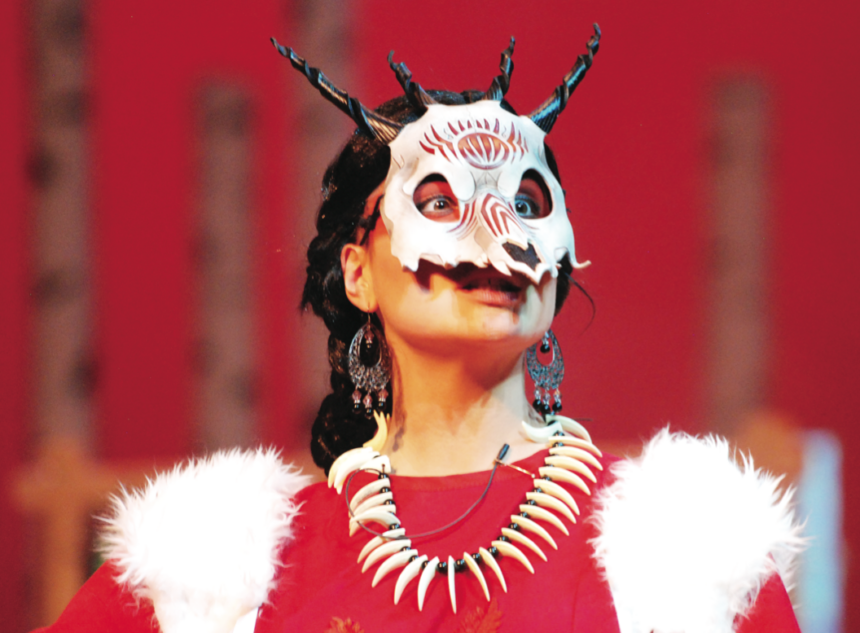The lights shift, casting a warm glow on the birch trees and log houses of Fort Michilimackinac. A chorus of Ojibwe and French settler women listen attentively to the keening song of a woman betrayed. The year is 1680. The woman is Medea.
And the setting is unusual for Euripides’s play, written in the 5th century B.C.
“This is the most Greek version of the play you’ll ever see,” said George Angell, director and professor of theater. “But it will seem less Greek because the actors aren’t wandering around wearing helmets with crests. The change of setting is only depicted visually.”
The Tower Player’s rendition, showing Nov. 14-17 in Markel Auditorium, keeps Euripides’ original language –– albeit in translation –– including place and character names, but the change of setting enabled them to resolve several problems found in modern productions of Greek tragedy, Angell said.
“The idea is not to make this show a rehash of ‘things ancient,’ but to bring it into our common experience here,” Angell said. “I was looking for a Michigan way, and the Ojibwe are a huge part of our shared heritage.”
The more research conducted by the dramaturgy class, the more they realized how strongly Greek and Native American cultures corresponded, dramaturg-of-record and chorus member, junior Anne Peterson said.
“We didn’t have to force a lot to make it work,” she said.
This is seen from the myth that precedes the action of Medea, told to the audience by chorus members before the show begins.
While the classical Jason sails into barbarian territory aboard his ship, The Argo, in search of the Golden Fleece, the voyageur Jason presented in the Tower Player’s production paddles into barbarian territory, via canoe, in search of valuable furs that can be sold for gold.
“At first I was very intrigued by the choice of setting. Then I was speculative. But when we began the rehearsal process, I knew it would work,” said senior Maggie Ball, who plays the title character of the show. “What we’re doing is a real blend of the French and Ojibwe cultures; we’re making this as historical as possible.”
One of the most significant elements of the show arising from both Greek and Native tradition is the use of a full chorus –– 13 women instead of the usual two or three seen in most modern productions, Angell said.
“With a chorus that large, it makes the whole show political,” he said. “Everyone has to convince the chorus they’re right. They also represent the audience, who can look to chorus for cues about how to take things.”
All of the choral interludes are sung and danced, as they were in Greek presentations of the play, but to an original score composed by Hillsdale alumna Eileen Hallagan that incorporates elements drawn from both Native American music and 1680’s French country songs.
The Greeks divided the chorus into “strophe” and “antistrophe,” Angell explained. these two groups sang against each other and danced in different directions, often presenting different points of view on the same subjects. In this case, the “strophe” is a native chorus and the “antistrophe” is a settler chorus.
Each sings and dances in their respective styles to highlight the contrast in cultures.
“The women of Corinth are the chorus,” Peterson said. “And the other characters have to convince us of their motivations. There’s allot about motherhood and what it means to have children, so we talk to Medea as she decides what to do.”
In addition, Medea’s opening speeches are sung from off stage, as originally intended.
“You never see that done either,” Angell said. “People say that there’s no surviving Greek music, so they don’t try.”
The Tower Players also adhere to the tradition of wearing masks onstage, though the speaking characters are exempt, as they would not be in Greek theater.
“We seldom see that,” said Angell. “But, as it turns out, masks were used a lot in woodland Indian culture. There is even a still-existent mask culture, The False Face Society. Our masks were strongly influenced by that.”
When it came to depicting violence on the stage, Angell decided on a compromise between the Greek convention of locating all violence off stage and “the modern trend to show everything,” by placing Medea’s mourning and the children’s murder behind a scrim and a screen of birch trees.
“You’ll see the silhouettes, but not everything,” said Peterson. “It’s a way to present the violence without having to work through the trouble of replicating realistic violence on stage. But the suggestion makes that moment a lot more powerful. We’re not in ancient Greece, so we get to do that
Angell’s dramaturgy work went on for over a year and a half, though he says he was working on the idea as a thought process for 20 years.
“The dramaturgy class has worked their butts off since the beginning of this summer,” said Angell. “I’ve never seen a group work so hard.”
There is a significant amount of detail in the program, lobby displays, and the historical re-enactment of a voyageur trading post set up outside of the theater entrance. The lobby will open at 7 p.m., while the show itself begins at 8 p.m.
As soon as the house opens, the chorus will begin their presentations of the action that precedes the play.
It is well worth the time to take advantage of all the information available, said Peterson.. Although the audience doesn’t need to know the myth or Ojibwe culture to understand the show, it makes for a particularly rich and engaging experience if they do.
“It’s just an amazing result of a team effort, said Ball. “And it truly is a team effort. There might be a title character, but it’s not about her. It’s about relationships and suffering and justice and what that means. A lot of work has gone into the show and we’re very excited to share that.”
vcooney@hillsdale.edu

